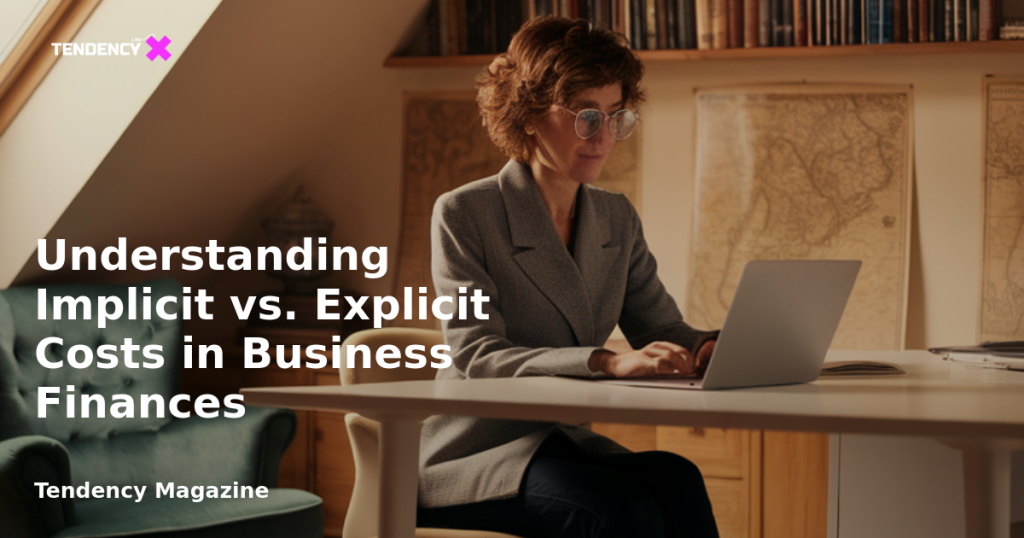Understanding Implicit vs. Explicit Costs in Business Finances

Table of Contents
- What are Implicit Costs?
- What are Explicit Costs?
- Accounting Profit vs. Economic Profit: What’s the Difference?
- How to Use Explicit Costs to Calculate Accounting Profit
- How to Use Implicit and Explicit Costs to Calculate Economic Profit
- Explicit vs. Implicit Costs FAQ
What are Implicit Costs?
Implicit costs, often referred to as opportunity costs, represent the potential income or benefits foregone when a specific decision is made. Unlike explicit costs, they don’t involve direct financial transactions and are typically absent from standard accounting records. Nevertheless, they are crucial economic considerations because they reflect the value of opportunities that were sacrificed.
Implicit costs can include:
- The Owner’s Time and Effort: When a business owner dedicates time to their own company, the implicit cost is the salary they could have earned elsewhere.
- Use of Owner’s Capital: If an owner invests personal funds into the business, the implicit cost is the interest or returns those funds could have generated in alternative investments.
- Use of Owner’s Property: Operating a business from a property owned by the proprietor incurs an implicit cost equivalent to the rent that could have been charged to another tenant.
- Depreciation of Tangible Assets: While depreciation is often recorded as an accounting entry, the economic implicit cost relates to the potential value lost by not having newer, more efficient assets.
Calculating implicit costs is essential for making informed economic decisions, even if they don’t appear on traditional balance sheets. Entrepreneurs often accept implicit costs for long-term gains. For instance, some business owners might forgo a salary initially to invest more into their business, with the expectation of future profitability.
What are Explicit Costs?
Explicit costs are direct, out-of-pocket expenses that a business incurs. These costs are tangible, measurable, and involve actual cash transactions. They are typically recorded in a company’s financial statements, such as the income statement and balance sheet.
Examples of explicit costs include:
- Wages and salaries paid to employees
- Office rental or facility leases
- Purchases of raw materials and supplies
- Utility bills (electricity, water, internet)
- Interest payments on loans
- Marketing and advertising expenses
- Insurance premiums
Essentially, if a financial transaction is documented and money changes hands, it is considered an explicit cost.
Accounting Profit vs. Economic Profit: What’s the Difference?
The distinction between explicit and implicit costs becomes particularly important when contrasting accounting profit with economic profit. These concepts offer different perspectives on a business’s success.
Accounting Profit
Accounting profit is the profit figure commonly seen on a company’s financial statements. It is calculated by subtracting explicit costs from total revenue. This measure reflects the financial gain from business operations as recorded in the books:
Accounting Profit = Total Revenue – Explicit Costs
Economic Profit
Economic profit provides a broader, more realistic measure of profitability, especially for long-term decision-making. It accounts for both implicit and explicit costs, including opportunity costs, to assess the true profitability of a venture:
Economic Profit = Total Revenue – (Explicit Costs + Implicit Costs)
The key difference lies in the inclusion of implicit costs. While accounting profit may indicate that a business is profitable, economic profit reveals whether the business is the most efficient use of resources compared to alternative opportunities. A business could have a positive accounting profit but a zero or negative economic profit, suggesting that the owner might earn more by pursuing different ventures.
How to Use Explicit Costs to Calculate Accounting Profit
To calculate accounting profit, follow these steps:
- Identify Total Revenue: Determine the total amount earned from sales of goods or services during a specific period.
- Add Up All Explicit Costs: List every direct, out-of-pocket expense incurred during the same period (e.g., wages, rent, utilities, advertising).
- Subtract Explicit Costs from Total Revenue: The result is your accounting profit.
For example, if a business has total sales revenue of £500,000 and explicit costs totaling £350,000 (wages, rent, materials, etc.), the accounting profit would be £150,000.
How to Use Implicit and Explicit Costs to Calculate Economic Profit
Calculating economic profit involves a comprehensive view of profitability:
- Calculate Accounting Profit: Follow the steps above to determine accounting profit.
- Identify and Quantify All Implicit Costs: Carefully consider any missed alternatives and quantify the monetary value of the owner’s time, capital, and other resources.
- Subtract Total Implicit Costs from Accounting Profit: This figure is your economic profit.
Using the previous example, if the implicit costs (e.g., foregone salary and interest) amount to £85,000, the economic profit would be £65,000. This indicates that the business is a worthwhile venture compared to the best alternatives for the owner’s time and capital.
Explicit vs. Implicit Costs FAQ
What is an example of an implicit cost?
An implicit cost example is the foregone annual salary of a business owner. If an entrepreneur leaves a job paying £70,000 per year to start their own business, that £70,000 is an implicit cost of running the new business. It represents potential income sacrificed, even though no money is directly paid out.
What is the difference between implicit and explicit costs?
The main difference is whether there is a direct cash outlay. Explicit costs involve direct payments, like rent or wages, and are recorded on financial statements. Implicit costs don’t involve actual payments but represent the value of opportunities or resources sacrificed.
How do you know if a cost is implicit or explicit?
To determine if a cost is implicit or explicit, ask two questions: Was there a direct cash payment or financial obligation? If yes, it’s an explicit cost. Was an opportunity or benefit given up without a cash exchange? If yes, it’s an implicit cost.
In conclusion, understanding both implicit and explicit costs is crucial for a comprehensive view of business profitability. By considering these costs, business owners can make informed decisions and optimize their economic outcomes.
2025 Tendency LTD. All rights reserved.

